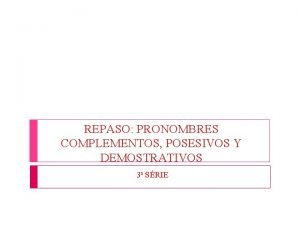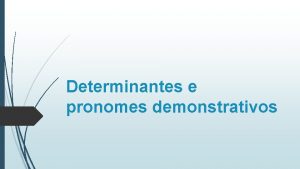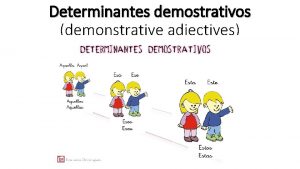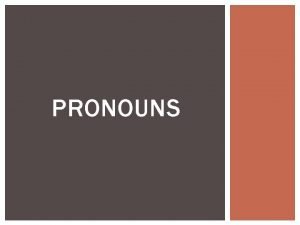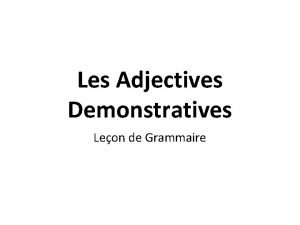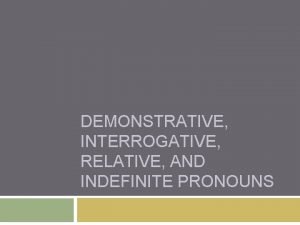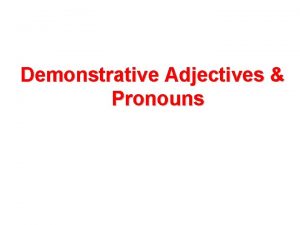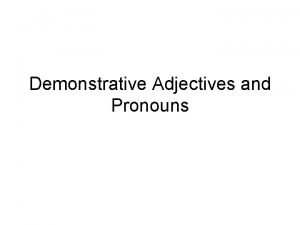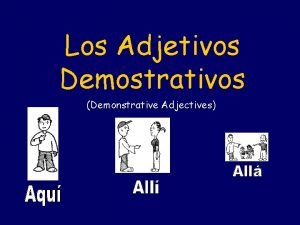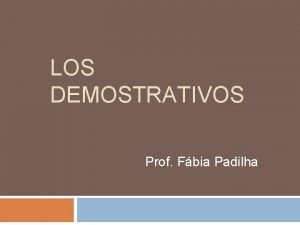Determinantes demostrativos demonstrative adjectives Significado y uso meaning













- Slides: 13

Determinantes demostrativos (demonstrative adjectives)

Significado y uso (meaning and usage ) • Words such as this and that, which we se to identify something, are known as demonstratives. • English has two set of demonstratives: -this, for something which is closer to us, whether in space or time. -that, for something which is further away from us. • Spanish has three sets of demonstratives: -este/esta (this) -ese/esa (that) -aquel/aquella (also meaning that), which is used to identify something which is even further away.

• The distinction between ese and aquel (that) is not always clear. But if something is far away, the more suitable word will be aquel: -Aquella es la montaña que visitaremos manana. -That’s the mountain we will visit tomorrow.

• Demonstratives in Spanish have masculine/feminine, and singular/plural forms, agreeing with the accompanying noun or the noun they refer to: Este tren→ this train Estos trenes→ these trains Esta puerta→ this door Estas puertas→ these doors Ese platano→ that banana Esos platanos→ those bananas Esa television→that TV Esas televisiones→those TV’s Aquel chico→ that boy Aquellos chicos→ those boys Aquella tienda→that store Aquellas tiendas→those stores


Demonstrative forms Masc. Sing. Fem. Sing. Translation este esta this ese esa that aquella that Masc. Plural Fem. Plural Translation estos estas these esos esas those aquellos aquellas those

• Este tren va a Valencia, ¿no? • No, el tren a Valencia es ese. • ¿Cuánto cuestan esas gafas de sol? • En aquellos tiempos no había internet

• • • • Bring all those bags over here. Translate these sentences into Spanish. Can you see that building? Yes, it is huge. My mother gave me this ring. Yesterday I forgot to answer those questions. Can you help me with these exercises? I don’t want you (masc. sing. )to go alone at that time, it is late. That dog is always making noise. If I had money I would buy that car. Close all those windows please, it is really cold. Can I use that phone? I lost mine. I remember that day when I lost that watch. Those buildings are really far away. This computer doesn’t work, we need a new one.

Rewrite the sentences in ‘’plural form’’, and translate them into Spanish. • 1. That is a dictionary. ___________ • 2. That is a baby. ___________ • 3. This is a present. ___________ • 4. This is an umbrella. ___________ • 5. That isn’t a hamster. ___________ • 6. Is that a newspaper? ___________ • 7. Is this a postcard? ___________ • 8. Is that a Spanish flag? ___________ • 9. Is this a fly? ___________ • 10. Is this a sheep? ___________

Cocinar Polite singular Polite plural Familiar singular Negative Polite Singular Negative Polite Plural Negative Familiar Singular Traducir Hacer Tener Correr Abrir Decir Dar Escuchar

• Circle the appropriate demonstrative pronoun in the parenthesis. Pay careful attention to the noun it replaces. 1. Prefiero la corbata roja, no (ése, ésa, esa) que está allí. 2. Me gusta aquella casa blanca, pero (éste, éstas) amarilla, no tanto. 3. Esas manzanas ahí están deliciosas, pero (éste, éstas, éstos) no están tan buenas. 4. Me gusta aquel automóvil pero (ése, ésa, ésos) que está allí es increible. 5. Este chaleco es chévere (cool) pero (aquel, aquélla) que lleva el señor es feo. 6. Las montañas detrás de la universidad son bonitas pero (aquél, aquéllas, aquéllos) son desoladas. 7. Prefiero las fresas del estado de Oregón no (ésas, ésa, ése) de California. 8. El equipo vestido de azul es más talentoso que (éste, ésta, este) en rojo. 9. Aquellos cuadros de Picasso me caen mucho mejor que (este, éstas, éstos) de Dalí. 10. Preferimos las uvas verdes, no (éstas, ésta, éstos) moradas. 11. La ropa hecha en Honduras es más barata que (aquél, aquéllas) hecha en Nueva York. 12. Las zanahorias del supermercado son mejores que (éstos, éstas, éste).

• Translate each of the following phrases. Do not translate the words that are in parenthesis – they are only there to help you identify the distance from the speaker. 1. those flowers (nearby) 2. that drugstore (nearby) 3. this (apricot right here) 4. those (shoes way over there) 5. these books (right here) 6. those clothes (nearby) 7. these apples (right here) 8. this map of Spain (right here) 9. those rivers (way over there) 10. that (bread nearby) 11. these (foods right here) 12. that (backpack way over there) 13. these (trees right here) 14. this year

Translation Translate each of the following phrases. Example: I prefer this tie not that one (nearby). Prefiero esta corbata, no esa. 1. I need this price, not that one. 2. 2. That class (over there) is bigger than this one. 3. 3. I like this watch, not that one (nearby). 4. Those shoes (over there) are more expensive than these. 5. That is difficult. (unspecified idea) 6. These exercises are easier than those.
 Determinantes demostrativos y pronombres demostrativos
Determinantes demostrativos y pronombres demostrativos Demostrativos
Demostrativos Pronombres posesivos
Pronombres posesivos Determinantes demonstrativos espanhol
Determinantes demonstrativos espanhol Determinantes demostrativos
Determinantes demostrativos Determinantes e pronomes possessivos e demonstrativos
Determinantes e pronomes possessivos e demonstrativos Personal possessive and demonstrative pronouns
Personal possessive and demonstrative pronouns Les adjectives demonstratives
Les adjectives demonstratives Is that a relative pronoun or demonstrative
Is that a relative pronoun or demonstrative Demonstrative and interrogative adjectives
Demonstrative and interrogative adjectives Demonstrative adjectives and pronouns spanish
Demonstrative adjectives and pronouns spanish Demonstrative adjectives and pronouns in spanish
Demonstrative adjectives and pronouns in spanish Demonstrative adjective in french
Demonstrative adjective in french Demonstrate adjective
Demonstrate adjective


